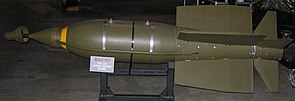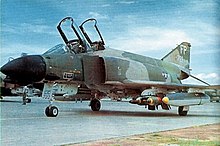BOLT-117
| BOLT-117 | |
|---|---|
| General Information | |
| Designation: | BOLT-117 (GBU-1 / B) |
| Type: | Laser guided glide bomb |
| Country of origin: | United States |
| Manufacturer: | Texas Instruments |
| Development: | 1962-1967 |
| Commissioning: | March 1967 |
| Technical specifications | |
| Furnishing | |
| Warhead: | 340 kg (M-117) |
| Weapon platforms: | McDonnell F-4D Phantom |
| List of bombs by country of origin | |
The Texas Instruments BOLT-117 ( Bo mb, L aser T erminal 117), later as GBU-1 / B referred (Guided Bomb Unit), was the first laser-guided bomb in the world.
History and technology
In 1962, the United States Army started the first trials and tests in the Redstone Arsenal to find out whether a laser beam was suitable as a target acquisition method. Three years later, this method was proven to work and the findings were shared with the United States Air Force . The companies Texas Instruments and North American Aviation were commissioned to build prototypes of these laser-guided bombs, which were new at the time. Both prototypes used the M-117 , a 340 kg free-fall bomb . Both prototypes were very similar so there was only one difference in price. Because Texas Instruments' construction was simpler and cheaper to design, it was put into service as the BOLT-117. But North American's design was evolving in parallel. In addition to the 9 built prototypes, Texas Instruments received the order to produce 50 additional kits for the M-117. Because of these two developments, people began to think about standards for the future development of laser-guided bombs. On July 20, 1967, it was decided to start the Paveway project, which resulted in a whole family of laser-guided bombs.
The BOLT-117, in addition to the M-117, which served as the base, consisted of a laser target acquisition and control kit, which is designated as the KMU-342. This consisted of a gimbal-mounted laser seeker on the tip of the bomb and control and guide fins that were attached to the rear of the bomb. In order for a carrier aircraft to be able to use the BOLT-117, it had to be equipped with an Airborne Laser Designator (ALD) laser target illumination container itself , or another aircraft had to illuminate the target with it. The weapons systems officer had an additional monitor in the cockpit that he could use to steer the laser in order to capture a target.
The first combat missions during the Vietnam War took place in May 1968 . There the 8th Tactical Fighter Wing tested the BOLT-117 with very good results. The circular error probable of about 9 meters was only for static targets such as bridges, and only under optimal conditions (good weather, no air defense). This was a huge step forward over conventional free-fall bombs, but they wanted it to be even better. So it came about that only a small number of BOLT-117 were built and the development of the GBU-2 / B was quickly carried out.
Web links
- GBU-1 / B to GBU-12 / B on designation-systems.net (en)
- BOLT-117 on nationalmuseum.af.mil (en)
- BOLT-117 on nd.edu (en)

